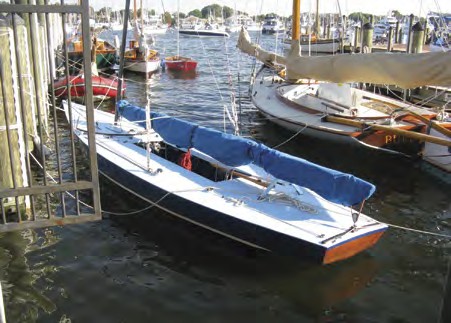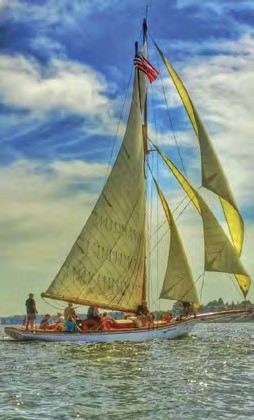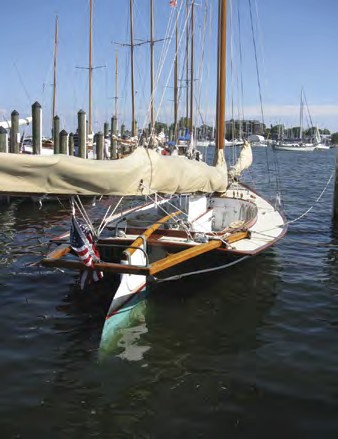Special Handicapping System Used
By Wayne Brown
 The Annapolis Harbor docks off Prince George Street in Annapolis, MD welcomed a large number of classic wooden sailboats on September 20, 2014. Streams of visitors and boat enthusiasts looked over the yachts and often went aboard to look below. All the boats were built in 1970 or earlier. The National Sailing Hall of Fame (NSHF) and the Chesapeake Traditional Sailing Association once again sponsored this 5th Annual Classic Wooden Sailboat Rendezvous & Race, which took place from the docks just beyond the NSHF building.
The Annapolis Harbor docks off Prince George Street in Annapolis, MD welcomed a large number of classic wooden sailboats on September 20, 2014. Streams of visitors and boat enthusiasts looked over the yachts and often went aboard to look below. All the boats were built in 1970 or earlier. The National Sailing Hall of Fame (NSHF) and the Chesapeake Traditional Sailing Association once again sponsored this 5th Annual Classic Wooden Sailboat Rendezvous & Race, which took place from the docks just beyond the NSHF building.
Built in 1924, Trout was the first of 12 Stars sent to the Gibson Island YC in California. Restored by Tom Gahs in 2004, she is the oldest Star in Chesapeake Bay. © Wayne Brown
On Sunday, September 21, there was a race that used a most unique handicapping system.
“We use the modified Portsmouth Yardstick,” explained Paul Miller, head of the Race Committee. “Every boat is rated to other boats as a percentage. Ratings have numbers like 97, 98, or 70. These are really references to a percentage speed ratio against the scratch boat.”
Sunday’s light wind was a problem so the 11 am start was postponed until 1 pm. Eddie Cutts, who with his brother Ron raced Spellbound, a 47-foot ketch designed and built by their father, Ed Cutts, said it was a “light, meandering wind, shifting around. At times it was six knots and at other times it was two knots.” He had praise for the winning skipper of Elf for sailing “a beautiful race.”
This was Rick Carrion, who said they were watching the breezes that piped up in different areas. Asked about his strategy, he said, “We played all the breezes and watched our current, because the current was coming into port. We tried to stay off the current.” But the current helped them in the repeating triangle course with a start and finish off the Naval Academy. “We came up along the western side of the channel and ran all the way down and came around the course. We just ate up all the other boats,” he said. “We were thrilled to do that.” The wind read 5.7 knots when Elf was passing the competition.
 Elf flew three jibs, the gaffed main and a working topsail, but not the jackyard topsail which goes 12 feet higher than the mast. There were 16 people on board and all played a part, including a seven-year-old boy named Severn who took a turn at the helm. George Lawley designed the 35-foot Boston Class cutter in 1888, but over time, Carrion said, she has been completely rebuilt. He donated her to the Antique Boat Restoration Guild, which has made recent repairs. Elf is a fine looking boat due to Lawley’s excellent design.
Elf flew three jibs, the gaffed main and a working topsail, but not the jackyard topsail which goes 12 feet higher than the mast. There were 16 people on board and all played a part, including a seven-year-old boy named Severn who took a turn at the helm. George Lawley designed the 35-foot Boston Class cutter in 1888, but over time, Carrion said, she has been completely rebuilt. He donated her to the Antique Boat Restoration Guild, which has made recent repairs. Elf is a fine looking boat due to Lawley’s excellent design.
Using the Portsmouth Yardstick
Paul Miller, speaking in the NSHF building, explained how he had sent all the previous results for the different boats to the Portsmouth Yardstick Committee. “There’s one in England, and one in the U.S. – US Sailing in Middleton, RI.” They publish a new value on their website for a large list of boats. For sailboats without a number, Paul has to do research which begins by asking the owners for the basic sail dimensions. “I go online and try to find more,” he said. “I go into the library and find – maybe – a book that the designer wrote.”
Elf finished first in the “Diesel” class for cruising boats. © Russell Levi
Then he uses something he called the Velocity Prediction Program. “You enter all the data about the sail areas, etc. It gives a prediction of how fast the boat is. You take the value for a speed of knots.” Comparing this with the scratch boat, he said, “gives me the percent ratio with the new boat…and one of our existing boats. The idea is for a low-tech informal race where the boats are shown in their best light.”
Ideally, all boats in a pursuit-type race should finish at the same time. A dinghy might start first, and the last to start might be the Star boats. “The key thing is we are given boats, not sailors,” he said. Some are active racers while others prefer cruising. “Some of the boats have racing quality sails, and some have cruising quality sails,” he said. “Each year they get adjusted as well, so what we see is the smaller lighter boats, because the course is so short, are tacking a lot. The big heavy boats don’t tack well, so they end up with a larger handicap number, because they end up being slower.”
 And, he said, handicaps drop for the smaller maneuverable boats. When told it was extensive and complicated research, he said, “Yes, but I’m a naval architect so it’s fun.” His smallest boat is just 47 inches in length, a computer controlled craft used for oceanographic research. His largest design is an 82-foot America’s Cup yacht. For more information, visit nshof.org.”
And, he said, handicaps drop for the smaller maneuverable boats. When told it was extensive and complicated research, he said, “Yes, but I’m a naval architect so it’s fun.” His smallest boat is just 47 inches in length, a computer controlled craft used for oceanographic research. His largest design is an 82-foot America’s Cup yacht. For more information, visit nshof.org.”
In shallow draft craft such as this sandbagger Bull, crew and sandbags shift for ballast. © Wayne Brown
Wayne Brown is the author of Ed Cutts: Designer, Boatbuilder, and “Cutts Method” Inventor. Log onto leewardpublications.com for more information.




